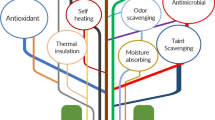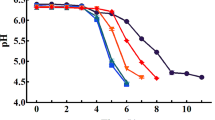Abstract
In this study, Alyssum homolocarpum (AH) and Lepidium sativum seed gum (LS) at different ratios 1:0, 1:1, and 0:1 utilized to encapsulate red onion extract (ROE). In the first step, the total phenolic content (TPC), total flavonoid content (TFC), and antioxidant activity of ROE were characterized. Further, the DPPH and FRAP assay showed that ROE at 1600 ppm exhibited highly antioxidant potential (DPPH = 88.36%, FRAP = 35.42%), and used for encapsulation. The chemical, microbial and sensory properties of beef fillets were monitored at days 0, 4, 8, 12, 16, and 20 of storage at 4 °C. Our results indicated that encapsulated ROE in AH: LS coating was more efficient in retardation of microbial chemical reactions of coated meat fillet and the shelf life was extended from 4 to 16 days due to inhibition of bacterial growth, reduction in pH, peroxide value, thiobarbituric value and microbial growth. Also, free ROE showed good preservative than 200 ppm of synthetic BHT preservative. This study confirmed that the encapsulated ROE in AH: LS coating, is a potential coating to improve the quality and shelf life of beef fillet.






Similar content being viewed by others
References
H. Ergezer, H.I. Kaya, Ö. ŞiMşek, Antioxidant and antimicrobial potential of artichoke (Cynara scolymus L.) extract in beef patties. Food Meas. (2018). https://doi.org/10.1007/s11694-017-9713-0
S.S. Tometri et al., Extraction and encapsulation of Laurus nobilis leaf extract with nano-liposome and its effect on oxidative, microbial, bacterial and sensory properties of minced beef. J. Food Meas. Charact. 14, 1–12 (2020)
Q. Ye, N. Georges, C. Selomulya, Microencapsulation of active ingredients in functional foods: from research stage to commercial food products. Trends Food Sci. Technol. 78, 167–179 (2018)
M. Esmaeili et al., Comparison of coating and nano-coating of chitosan-Lepidium sativum seed gum composites on quality and shelf life of beef. J. Food Meas. Charact. 15, 341–352 (2021)
A.M. Langroodi, H. Tajik, T. Mehdizadeh, Preservative Effects of Sumac Hydro-Alcoholic Extract and Chitosan Coating Enriched along with Zataria Multiflora Boiss Essential Oil on the Quality of Beef during Storage. Veterinary Research Forum (Faculty of Veterinary Medicine, Urmia University, Urmia, 2018).
Ș-A. Milea et al., Widen the functionality of flavonoids from yellow onion skins through extraction and microencapsulation in whey proteins hydrolysates and different polymers. J. Food Eng. 251, 29–35 (2019)
J. Santas, M.P. Almajano, R. Carbó, Antimicrobial and antioxidant activity of crude onion (Allium cepa, L.) extracts. Int. J. Food Sci. Technol. 45(2), 403–409 (2010)
C.M. Manohar et al., Antioxidant activity of polyphenols from Ontario grown onion varieties using pressurized low polarity water technology. J. Funct. Foods 31, 52–62 (2017)
R. Razavi et al., Fabrication of zein/alginate delivery system for nanofood model based on pumpkin. Int. J. Biol. Macromol. 165, 3123–3134 (2020)
R.E. Kenari et al., Optimization of Iranian golpar (Heracleum persicum) extract encapsulation using sage (Salvia macrosiphon) seed gum: chitosan as a wall materials and its effect on the shelf life of soybean oil during storage. J. Food Meas. Charact. 14, 2829–2839 (2020)
M. Yazdan-Bakhsh et al., Evaluation of antioxidant properties of Heracleum Lasiopetalum extract in multilayer nanoemulsion with biopolymer coating to control oxidative stability of sunflower oil. J. Food Meas. Charact. 15, 1–10 (2020)
B.A. Behbahani, A.A.I. Fooladi, Shirazi balangu (Lallemantia royleana) seed mucilage: chemical composition, molecular weight, biological activity and its evaluation as edible coating on beefs. Int. J. Biol. Macromol. 114, 882–889 (2018)
M. Hosseinialhashemi et al., The aplication of Pistacia khinjuk extract nanoemulsion in a biopolymeric coating to improve the shelf life extension of sunflower oil. Food Sci. Nutr. 9(2), 920–928 (2021)
S. Sharifimehr, N. Soltanizadeh, S.A.H. Goli, Physicochemical properties of fried shrimp coated with bio-nano-coating containing eugenol and Aloe vera. LWT 109, 33–39 (2019)
A. Taheri, S.M. Razavi, Fabrication of cress seed gum nanoparticles, an anionic polysaccharide, using desolvation technique: An optimization study. BioNanoScience 5(2), 104–116 (2015)
L. Monjazeb Marvdashti et al., Optimization of edible Alyssum homalocarpum seed gum-chitosan coating formulation to improve the postharvest storage potential and quality of apricot (Prunus armeniaca L.). J. Food Saf. 40(4), e12805 (2020)
K. Khoshakhlagh et al., Development and characterization of electrosprayed Alyssum homolocarpum seed gum nanoparticles for encapsulation of d-limonene. J. Colloid Interface Sci. 490, 562–575 (2017)
N.A. Sagar, S. Pareek, G.A. Gonzalez-Aguilar, Quantification of flavonoids, total phenols and antioxidant properties of onion skin: a comparative study of fifteen Indian cultivars. J. Food Sci. Technol. 57, 1–10 (2020)
M.B. Hossain et al., Enrichment and assessment of the contributions of the major polyphenols to the total antioxidant activity of onion extracts: A fractionation by flash chromatography approach. Antioxidants 7(12), 175 (2018)
M. Volpe et al., Active edible coating effectiveness in shelf-life enhancement of trout (Oncorhynchusmykiss) fillets. LWT-Food Sci. Technol. 60(1), 615–622 (2015)
AOCS, Official methods and recommended practices of the AMOS. 2004: AMOS press Champaign.
M. Jridi et al., Effects of active gelatin coated with henna (L. inermis) extract on beef meat quality during chilled storage. Food Control 84, 238–245 (2018)
Q. Liu et al., Effects of nanoemulsion-based active coatings with composite mixture of star anise essential oil, polylysine, and nisin on the quality and shelf life of ready-to-eat Yao meat products. Food Control 107, 106771 (2020)
M.H. Alu’datt et al., Phenolic contents in vitro antioxidant activities and biological properties, and HPLC profiles of free and conjugated phenolics extracted from onion, pomegranate, grape, and apple. Int. J. Food Prop. 20(22), 1823–1837 (2017)
Razavi, R. and R. Esmaeilzadeh Kenari, Antioxidant activity of red onion (Allium cepa L.) peel extract produced by maceration, ultrasonic assisted and supercritical extraction techniques. 2016.
D. Ali et al., Effect of Extraction Method and Solvent Ratio on Antioxidant Activity of Dayak Onion Extract. IOP Conference Series: Earth and Environmental Science (IOP Publishing, Bristol, 2020).
Lenkova, M., et al., Evaluation and comparison of the content of total polyphenols and antioxidant activity of selected species of the genus Allium. Journal of Central European Agriculture. 2016.
A. Cheng et al., Comparison of phenolic content and antioxidant capacity of red and yellow onions. Czech J. Food Sci. 31(5), 501 (2013)
X. Lu et al., Determination of quercetins in onion (Allium cepa) using infrared spectroscopy. J. Agric. Food Chem. 59(12), 6376–6382 (2011)
S.R. Javadian, S.R. Shahosseini, P. Ariaii, The effects of liposomal encapsulated thyme extract on the quality of fish mince and Escherichia coli O157: H7 inhibition during refrigerated storage. J. Aquat. Food Prod. Technol. 26(1), 115–123 (2017)
M. Hassani, S. Hasani, Nano-encapsulation of thyme essential oil in chitosan-Arabic gum system: evaluation of its antioxidant and antimicrobial properties. Trends Phytochem. Res. 2(2), 75–82 (2018)
M. Anvari et al., Compositional characterization and rheological properties of an anionic gum from Alyssum homolocarpum seeds. Food Hydrocoll. 52, 766–773 (2016)
R. Branciari et al., Effect of dietary treatment with olive oil by-product (olive cake) on physicochemical, sensory and microbial characteristics of beef during storage. Ital. J. Food Saf. (2015). https://doi.org/10.4081/ijfs.2015.5496
O.B. Faluyi, A.A. Akintomide, G. Onibi, Antimicrobial and antioxidant effects of red onion (Allium cepa) on unrefrigerated broiler chicken meat. Anim. Res. Int. 17(2), 3665–3673 (2020)
Y. Yanar, Quality changes of hot smoked catfish (Clarias gariepinus) during refrigerated storage. J. Muscle Foods 18(4), 391–400 (2007)
Alexandre, S., et al., Use of alginate edible coating and basil (Ocimum spp) extracts on beef characteristics during storage. Journal of Food Science and Technology, 2020: 1–9.
M. Campo et al., Flavour perception of oxidation in beef. Meat Sci. 72(2), 303–311 (2006)
R. Metrani et al., Comparative metabolomics profiling of polyphenols, nutrients and antioxidant activities of two red onion (Allium cepa L.) cultivars. Plants 9(9), 1077 (2020)
A.C.P. Vital et al., Effect of edible and active coating (with rosemary and oregano essential oils) on beef characteristics and consumer acceptability. PLoS ONE 11(8), e0160535 (2016)
V. Mahdavi, S.E. Hosseini, A. Sharifan, Effect of edible chitosan film enriched with anise (Pimpinella anisum L.) essential oil on shelf life and quality of the chicken burger. Food Sci. Nutr. 6(2), 269–279 (2018)
M. Jouki et al., Effect of quince seed mucilage edible films incorporated with oregano or thyme essential oil on shelf life extension of refrigerated rainbow trout fillets. Int. J. Food Microbiol. 174, 88–97 (2014)
Author information
Authors and Affiliations
Corresponding author
Additional information
Publisher's Note
Springer Nature remains neutral with regard to jurisdictional claims in published maps and institutional affiliations.
Rights and permissions
About this article
Cite this article
Sarvinehbaghi, M.B., Ahmadi, M., Shiran, M. et al. Antioxidant and antimicrobial activity of red onion (Allium cepa, L.) extract nanoencapsulated in native seed gums coating and its effect on shelf-life extension of beef fillet. Food Measure 15, 4771–4780 (2021). https://doi.org/10.1007/s11694-021-00985-9
Received:
Accepted:
Published:
Issue Date:
DOI: https://doi.org/10.1007/s11694-021-00985-9




